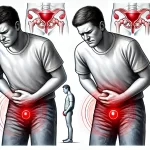We all know the benefits of exercising regularly. Where most people perform exercises to lose weight or help with control of diabetes and hypertension, some types of exercise can also improve bowel, bladder and even erectile functions.
Australian physiotherapist, Michelle Kenway who is author of the international best selling series of Inside Out – Pelvic Floor Safe Exercise and has comprehensive experience spanning acute hospital settings, private practice, and community, recommends pelvic floor therapy for pelvic floor problems, post operative pelvic floor surgery and musculoskeletal problems.
What is The Pelvic Floor?
The pelvic floor is a group of muscles, ligaments, tendons, nerves and connective tissues that span the bottom of the pelvis and support the bladder and bowel (consequently helping with bowel, bladder, and sexual function, and the stability of the pelvis as a whole).
In men, the pelvic floor supports the bladder, bowel, urethra and rectum. In women, the pelvic floor supports the bladder, uterus, and rectum.
In both men and women, the pelvic floor plays an important role in bladder and bowel function. When your pelvic floor isn’t working optimally, it can greatly affect your quality of life and lead to symptoms such as chronic pelvic pain, painful sex, difficulty with urination or bowel movements, erectile dysfunction, incontinence, constipation, and more.
What Causes Pelvic Floor Dysfunction In Men?
Several factors can result in pelvic floor muscle dysfunction in men, including:
- Age
- Obesity
- Chronic coughing
- Prostate surgery
- Chronic constipation
- Pain
What Is Male Pelvic Floor Therapy?
Male pelvic floor therapy is a specialized physical therapy that involves several exercises designed to treat dysfunctions related to the pelvic floor muscles in men. These muscles support various organs, control bladder and bowel functions, and play a role in sexual health. Issues like chronic pelvic pain, urinary incontinence, erectile dysfunction, and post-surgical recovery (such as after prostate surgery) can arise from weak or tight pelvic floor muscles. Male pelvic floor therapy involves tailored exercises, manual techniques, biofeedback, and education to strengthen or relax these muscles, aiming to restore normal function, alleviate pain, and improve quality of life.
Pelvic Floor Therapy Exercises to Perform
1. Kegel Exercises
Kegel exercise is evidence-based training for the pelvic floor muscles. It can:
- Strengthen the pelvic floor muscles
- Relieve pelvic organ prolapse symptoms
- Improve bladder and bowel control
- Promote recovery after prolapse surgery or hysterectomy
- Improve sexual sensation and arousal
Kegel exercises are the foundation of pelvic floor therapy. These exercises involve contracting and then relaxing your pelvic floor muscles.
How to do Kegel Exercises
Follow these steps to exercise your pelvic floor muscles:
- Feel your pelvic floor muscles in and around your urethra, vagina and anus
- Squeeze and lift your pelvic floor openings inwards
- Keep squeezing and lifting your pelvic openings for up to 10 seconds
- Breathe normally throughout your pelvic floor exercise
- Slowly release your pelvic floor muscles back to resting
- Relax your pelvic floor muscles by breathing into your belly for up to 2 minutes
Allow your pelvic floor to rest and recover before repeating this exercise again.

How Many Kegel Repetitions to Perform
For best results it’s important to do the correct number of Kegels. Strengthen your pelvic floor muscles by:
- Contracting your pelvic floor muscles up to 10 seconds
- Repeat these contractions up to 8-12 times in a row for one complete set of exercises
- Relax and rest your pelvic floor muscles between every effort
- Aim to complete 3 sets of pelvic exercises throughout the day
2. Quick Flicks
This is yet another exercise that can help you tighten your pelvic floor muscles. It can improve the ability to quickly contract and release the pelvic floor.
- How to do it:
- Tighten the pelvic floor muscles as quickly as you can.
- Hold the contraction for just 1 second and then immediately release.
- Do 10 repetitions, resting for a few seconds between each.
3. Bridge Exercise
This exercise engages the pelvic floor and strengthen surrounding muscles like the glutes and core.
- How to do it:
- Lie on your back with your knees bent and feet flat on the floor, hip-width apart.
- Engage your pelvic floor muscles and lift your hips off the floor, squeezing your glutes at the top.
- Hold this position for a few seconds, then slowly lower your hips back to the floor.
- Repeat 10-15 times.
4. Deep Breathing with Pelvic Floor Relaxation
Helps relax the pelvic floor muscles and improve control.
- How to do it:
- Sit or lie down in a comfortable position.
- Take a deep breath in through your nose, letting your abdomen expand fully.
- As you exhale, focus on releasing any tension in your pelvic floor muscles.
- Repeat this breathing exercise for 5 minutes, focusing on a gentle relaxation of the pelvic floor.
5. Pelvic Tilts
Promotes flexibility and control in the pelvic area.
- How to do it:
- Lie on your back with your knees bent and feet flat on the floor.
- Tighten your pelvic floor muscles and tilt your pelvis upward, flattening your lower back against the floor.
- Hold for 3 seconds, then release and return to a neutral spine.
- Repeat 10-15 times.
6. Adductor Squeeze
Strengthens the pelvic floor in combination with inner thigh muscles.
- How to do it:
- Sit on a chair with a small exercise ball or a pillow between your knees.
- Squeeze the ball or pillow, engaging your pelvic floor muscles simultaneously.
- Hold for 3-5 seconds, then release.
- Repeat 10-15 times.
Additional Tips:
Mind-Muscle Connection: Focus on the specific muscles you’re engaging, and don’t use surrounding muscles like your thighs or buttocks to compensate.
Consistency: Like any other exercise routine, consistency is key to seeing results. Try to do the exercises daily.
Breathing: It’s important to breathe normally and not hold your breath while doing pelvic floor exercises.
Who Needs Male Pelvic Floor Therapy?
Men with pelvic floor dysfunction often experience a variety of symptoms, ranging from discomfort to significant functional impairment. Common conditions benefiting from pelvic floor therapy include:
1. Urinary Incontinence
2. Chronic Pelvic Pain Syndrome (CPPS)
3. Post-Prostatectomy Recovery
4. Erectile Dysfunction (ED)
5. Bowel Dysfunction
6. Pudendal Neuralgia
Conclusion
Male pelvic floor therapy is a highly effective, non-invasive treatment that Improves helps a range of pelvic-related disorders, from urinary incontinence to erectile dysfunction and pelvic pain. It can be very beneficial for men suffering from pelvic floor dysfunction and can improve overall quality of life. If you experience any of these symptoms, consult a healthcare provider to explore whether pelvic floor therapy is right for you.
If you want to learn more about how to improve erectile function, we recommend you look at our penile traction therapy and penile extenders articles.
Disclaimer:
No content on this site, regardless of date, should ever be used as a substitute for direct medical advice from your doctor or other qualified clinician.


